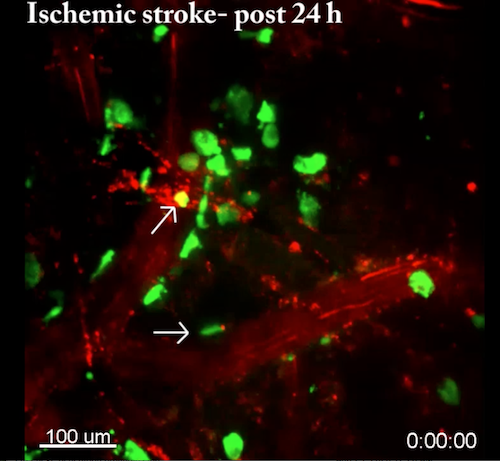|

CLICK ON weeks 0 - 40 and follow along every 2 weeks of fetal development
|
||||||||||||||||||||||||||||
|
Developmental Biology - Neonatal Stroke Strokes in Babies Surprisingly Common Neonatal strokes are interruptions in blood flow to an infant's brain in the first 28 days following birth. They have a wide variety of causes, from blood clots to developmental abnormalities. In some cases there are no symptoms - until much later in life when a child may develop speech difficulties and/or balance problems resulting from an undiagnosed brain injury. In damaging strokes, Kuan found, there is an initial rush of monocytes, which gradually transform into microglia. This lasts at least 62 days after an initial stroke event. Some of these monocytes ultimately remain reprogrammed as microglia and become permanent defense cells within the brain. The research invites new questions: "Can monocyte descended microglia impair brain development in infants who suffer newborn stroke and lead to neurological deficits? Can these former 'monocytes' be manipulated to improve outcomes of newborn brain injury? These fascinating questions beg for more research, explains Hong-Ru Chen PhD, first author of the new study. Abstract Whether monocytes contribute to the brain microglial pool in development or after brain injury remains contentious. To address this issue, we generated CCR2-CreER mice to track monocyte derivatives in a tamoxifen-inducible manner. This method labeled Ly6Chi and Ly6Clo monocytes after tamoxifen dosing and detected a surge of perivascular macrophages before blood-brain barrier breakdown in adult stroke. When dosed by tamoxifen at embryonic day 17 (E17), this method captured fetal hematopoietic cells at E18, subdural Ki67+ ameboid cells at postnatal day 2 (P2), and perivascular microglia, leptomeningeal macrophages, and Iba1+Tmem119+P2RY12+ parenchymal microglia in selective brain regions at P24. Furthermore, this fate mapping strategy revealed an acute influx of monocytes after neonatal stroke, which gradually transformed into a ramified morphology and expressed microglial marker genes (Sall1, Tmem119, and P2RY12) for at least 62 days after injury. These results suggest an underappreciated level of monocyte-to-microglia transition in development and after neonatal stroke. Authors Hong-Ru Chen, Yu-Yo Sun, Ching-Wen Chen, Yi-Min Kuo, Irena S. Kuan, Zheng-Rong Tiger Li, Jonah C. Short-Miller, Marchelle R. Smucker and Chia-Yi Kuan. Acknowledgements The research was supported by National Institutes of Health grants NS095064, NS100419, NS108763 and NS106592. Hong-Ru Chen was supported by American Heart Association postdoctoral fellowship 18POST34080334. Return to top of page. | Sep 9 2020 Fetal Timeline Maternal Timeline News  Four Movies are available to download, depicting aspects of monocyte/microglia adaptation. CREDIT The Authors.
|
||||||||||||||||||||||||||||

